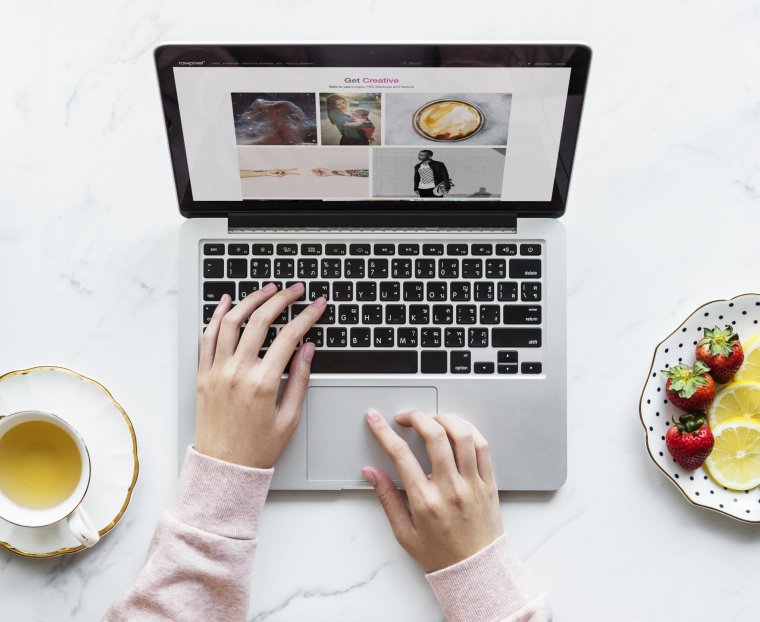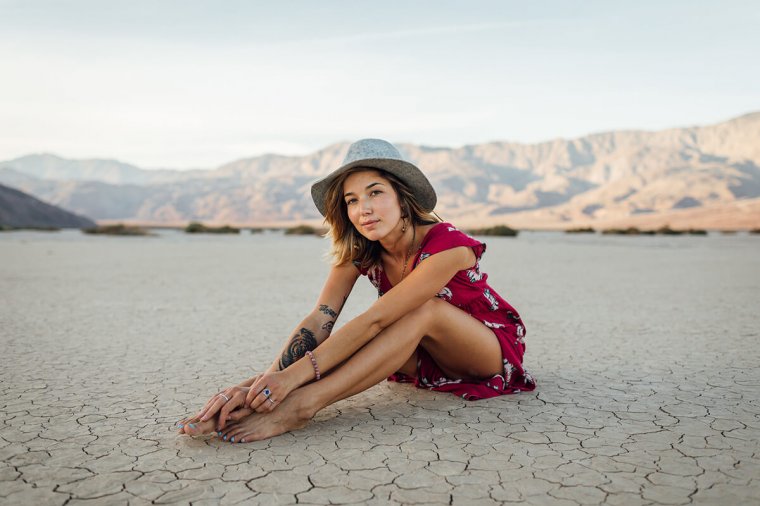
Becoming a freelance photographer can be a rough road when you’re first starting out, but it can also turn into an amazing freelance photography career, if you put in the work. In this article, we’ll give you tips to make your freelancing endeavors successful, discuss some of the the pros and cons of becoming a freelance photographer, and talk about the common mistakes people make when they first get started.
Table of Contents
Before I sold fine art prints, I used to sell hair straighteners at trade shows. I was really good at it, and I sold a lot . When my customers walked away from me after their purchase, I hoped to never see them again because if I did, it usually meant they wanted to return it or yell at me.
When I first started selling my art, I didn’t keep in touch with my clients. I quickly realized that I didn’t know who my clients were, which meant I didn’t know how to get in touch with them about shows they might be interested in going to, or new work they might be interested in purchasing or sharing with others.
Make sure to keep your client’s information and start a mailing list right away. Even if you don’t send out your first email until you have enough content, make sure to keep a list of the people who are interested in your freelance photography work. Previous and current clients should be included on your list, as well as people you have personally engaged with and who have expressed interest in what you are doing. Don’t spam people you don’t know.
When everyone is constantly being bombarded with information from social media, so catching someone’s attention is difficult. Email inboxes are a great place to catch a customer’s attention because they are checked regularly, and often have very high user engagement. This makes mailing lists mandatory to keep in touch with clients about news, promotions, and events.
When I first started selling fine-art prints, I thought I needed to focus only on selling prints at high prices, and that it would be sufficient to only sell artwork only through galleries. This greatly restricted the volume of people who could purchase my work, and it came with a big pay cut as well.
I decided something needed to change. After creating a few prints at a lower cost and selling them anywhere I could, I saw that all kinds of people could access my freelance photography work, not only top shelf art collectors. I continued to look for all kinds of ways to apply my photography skills and formulated many sources of income.
There are more avenues of revenue then you may think. Don’t be fixated on the one type of income, one type of client, or even one type of style of work. Brainstorm all kinds of ways to use your photography services, skills, and products to create your overall freelance photographer salary.
For example, if you know a lot of Adobe Photoshop, you could create Adobe Photoshop tutorials and sell them online. If you know a lot about photography, maybe you can write an e-book about how to get started. You might also explore selling photos on stock photography websites. Once you have a few streams of income, you can start choosing what you want to focus on, and even what you can automate.
Technology is changing and improving faster than ever. It’s important to remember that the market changes with technology too.
Moving images might be on their way to replace still ones, for example. If you’re a professional freelance photographer, that might mean you need to learn videography to keep up with what clients need. If you don’t do this, a potential client might pick someone else for the job. Pay attention to what’s changing and constantly pick up new photography skills in your trade.
There’s a lot of content on the internet about how you should never work for free or at a lower cost than industry standards. Doing work for free is not a terrible thing—if you do it strategically. You can trade free work for something of value. Ask your client to refer you to three people after you’ve done the job for them. They can also write a testimonial for you to include on your website or LinkedIn profile. Make sure to treat free work as if you are getting paid, and do the best job you can.
Keep in mind that people will think that the way you do unpaid work represents the way you do a paid job.
Another thing you can do is trade services. I started trading photography services with other artists when we can both benefit from each other’s help. I recently did a headshot for a writer who, in exchange for the shoot, helped me write a grant proposal. I’ve also asked someone who specialized in graphic design to create a logo for me in exchange for a print.
Make sure that you get familiar with the freelance lifestyle and are okay with it. Doing different jobs for different clients could mean getting calls to do freelance work the next day or even on the same day. It could mean having extremely long hours with little sleep. It could mean prolonged periods without a single freelance job. Your lifestyle might even affect your relationships.
Freelancing is a very entrepreneurial endeavor that usually works for someone who is self-motivated and is a self-starter and doesn’t need a boss to get work done. There are a lot of pros and cons to weigh when it comes to deciding to go freelance, so make sure it suits you and how you operate.
As mentioned, freelance photography isn’t for everyone. As many pros as there are, there are a few cons as well. Here are just a few:
When it comes to being a photographer or videographer of any sort, being exploited usually follows. This happens when you’re talented and can produce quality work, but others seek to reap the benefit of that due to a friendship.
I found this happening a little too often when I was a beginner in photography, and started to share my work with friends and family. I was then asked to carry my camera when going to meet up with them, and eventually asked to take “some shots” at some point. This became very annoying, as I was not always in the mood or frame of mind to shoot, but at the time I did not want to come off as mean or disrespectful to my friends or family.
Eventually, I got frustrated enough to let it be known that I will not be capturing any picture or content unless I willingly want to do it or am being compensated. If you value your work and yourself, you should demand that same respect from others as well.
This exploitation often doesn’t only come from friends, but also companies and clients. Most photographers and videographer creating their prices and package deals around the duration it will take to complete photography jobs. I’ve experienced times where a client would make a one-hour booking, claiming to only shoot “a few things,” and then I end up doing a three to four hour session that was not planned. These clients either expect to pay the same price or ask for a discounted price when they gave you more work than you signed up for. This is probably one of the most annoying things when it comes to freelance photography.
With freelance photography, there are often issues with payment. You will meet or interact with client or companies who don’t respect you enough as a freelance photography business owner or a creative to pay the fee for your services. Most of them will even hesitate to pay a booking fee, much less full prices.
This not only indicates a sense of disrespect, but also creates room for tension and awkwardness when you should be paid what you’re owed or what your work is valued. You will soon find yourself often having to explain the breakdown of your prices to some clients, which will become annoying over a certain period of time.
I believe this is very common among all photographers, but in the freelance world, it’s very stressful. As a freelance photographer, you encounter many clients who just don’t understand the process of editing and how it works. Clients can sometimes be annoying once you’ve completed a session and have been paid in full. You end up getting emails, messages or phone calls just a day or two after you’ve completed a session, asking if the images are ready. This then puts pressure on you to edit as fast as possible to meet the unrealistic demands of your clients.
I encourage freelance photographers to create a disclaimer with a reasonable turnover time of images before accepting or beginning photography jobs.
No boss or supervisor can give you the freedom to work whenever you want. This is one of the biggest perks of being a freelance photographer and videographer. Being able to set your hours and work in your spare time can afford you many things.
The freedom to travel or even work on the move is an option without any consequences to you. You also have the freedom of working wherever you’re comfortable. So, as a freelance photographer if you’ve completed a photography session a day ago, you’re not obligated to stay home in your workspace and edit if you don’t want to.
In the world of freelance photography, you have the potential to make at least 45 percent more income than the regular working individual. I have personally experienced this when I asked a few close friends and family members what their monthly income was, and to my surprise, I couldn’t believe it. I was able to make at least twice the monthly salary of a regular 9-5 worker in the space of doing just a few photography sessions. This helped me understand that time is definitely money.
Anything can happen when you’re a freelance photographer, so the opportunities are endless. As a freelance photographer, I believe you get back as much as you put into your career. For example, if you don’t try to network and expand your reach to companies and new clients, then you can only make so much income and no more. You control your destiny, and as cliche as it might sound, it is a fact.
In this day and age, having a 9-5 is a prison that many people aspire to escape. You find there are more and more individuals who turn to starting their own business venture or company rather than working for someone else. I can’t say I disagree with this, as I am one of those people as well. I have always had the stern belief that it’s important to get working on your own dreams before someone hires you to work on theirs. Being a freelance photographer is probably one of the best and scary decisions I ever made.
Like everything in this world, being a freelance photographer has its challenges that you will eventually face, but you will also eventually overcome them as well. These challenges can include:
When you become a freelance photographer or videographer, sometimes you turn into an introvert. You’re often glued to your workspace, perfecting your images or videos, and probably only leave your desk for a few things, like eating and bathing. You really start to become someone who is not as sociable as you would hope to be.

After awhile, I started to notice that being an introvert had an effect not only on my social life, but also with my relationship with others as well. I often found myself ignoring those who were trying to invite me to places to be social, just because I didn’t want to use my energy to entertain conversations and would rather work on my craft.
I was forced to come out of this stage because not only was it damaging my relationships with others, but it was also affecting my networking skills. To overcome this, I began to host editing parties where I would invite a few photographers and videographers to my house and we would all help each other and give feedback on our individual projects. This helped me see things from a different perspective and it became refreshing way to interact with others who were as creative as I am.
This has to be one of the most difficult challenges I faced as a freelance photographer. Once you become a freelance photographer or videographer, it’s hard to know how much money you should charge. This is determined by the consistency of work or projects received from clients, as well as the number of clients you have.
Once you’ve established a pattern that has remained consistent for a certain period of time, then you can estimate a minimum freelance photographer salary. Inconsistent income as a freelancer made it difficult to make certain financial plans because there’s no telling if you will have the same or less income the following month. Overcoming this took a little time, but the solution became very simple: I began to put my commercial photography clients and product photography clients on a monthly retainer.

This gave them the freedom to book a certain numbers of hours per month at a set cost with the assurance that they will get their project done in a timely manner. Doing this to most of my corporate clients gave me a sense of comfort knowing that these contracts are almost always in place, and there is a set amount of income that will be made on a monthly basis.
As freelancers, you’re always hustling and trying to recruit new clients. You should always be prepared to pitch an idea to sell yourself on the spot to someone who could potentially become a client. However, this can be exhausting because you start to feel like you’re working around the clock. This helps you understand and appreciate what people mean when they say “the hustle never stops”. To overcome this, I started to pace myself and try not to do too much to the point where I’m becoming unhappy or annoyed with the choices I’ve made.
With the understanding that time is money as a freelancer, you should always try to do as much as you can in the time that you have, otherwise, you risk forcing yourself into doing a project without passion and just for money. At that point, you’re no longer doing it because you have a passion for it or love it, but more so to get some bills paid.
I am probably still a huge victim of this one. As a freelancer, you’re your own boss, which means you set your own work hours and your own rules. However, some of us are not always as disciplined as we would hope to be, so we end up doing a thousand other things and get distracted from doing the job or project we are getting paid to do.
At this point, you begin to appreciate people who have supervisors to help keep them in line. There were often times where I had a vast amount of projects to get done, but then I decided to give in to laziness and sleep the whole day and do nothing. If I’m being completely honest, this still happens on my worst days.

To overcome this, I started to invest my time into a daily schedule. I made it my duty to remind myself each day as to what my dreams are, telling myself that if I want to get there, then I can’t keep sleeping or getting distracted by things that are not in line with what I am trying to accomplish. Once this is done, you will find yourself a lot more focused and driven, even on your lazy days, because your goals and dreams become all you need to get going.
Everybody makes mistakes, but that doesn’t mean we have to make the same mistakes. Sharing our experiences and learning from one another is one of the best ways to evolve quickly. When we end up in tricky situations, we’ll know what to do based on the wisdom that was passed down to us from a professional photographer. And when we experience epic failures of our own, we’ll have the opportunity to stop others from repeating our mistakes.

During one of my first portrait photoshoots, I remember giving my model very specific posing tips. These poses looked incredible on my other subjects, so I assumed they’d look just as flattering when my model tried them out. They didn’t, which confused me and made her feel uncomfortable. Yikes!
Fortunately, we found a solution that I still use to this day: get to know your model’s preferences and best angles before you give them instructions. This leads me to my next mistake…
![]()
Though many of my models and clients are my friends, some are acquaintances whose life stories I am completely unaware of. There have been times where I immediately started taking photos of models, which led to a lot of miscommunication. Not knowing what my subjects wanted created a large void in my creative work. Get to know your subjects before your shoot. This can be as simple as taking a walk, having coffee, or Skyping together. This is especially crucial when you specialize in wedding photography, portrait photography, or fashion photography.
Make sure you let your client express their opinions. They shouldn’t feel like inanimate objects when they’re in front of your camera. By giving them the opportunity to use their voice, you’ll be able to use your creativity more efficiently. You might also learn new things thanks to their input.
![]()
I was very young when I started taking photos. All the photographers I looked up to were professionals who charged hundreds of dollars for a single photo shoot. I was afraid that the amount I charged would be criticized because of my age, experience, and equipment. Fueled by those fears, I lowered my prices significantly. This stopped me from fully enjoying my shoots.
If you believe that what you’re charging is fair, don’t be embarrassed by it. Your time is valuable. Your willingness to photograph other people’s beauty is admirable. Don’t forget that.

This is a mistake that I’ve been making for many years. Once I got to a point where I felt comfortable with my skills, I stopped learning about other photography genres. I started focusing on portrait photography only. When I started to develop an interest in other genres (travel photography and fashion photography, for instance), I was afraid it was too late to learn anything. This prevented my work from growing as much as it deserved to.
Regardless of your experience, always consider yourself a student. Don’t be afraid of learning new things, experimenting with new genres, and just being a beginner. Everything you learn will open new doors for you.

Instead of regretting your failures, let them help you improve as a photographer. Learn from them, learn from others, and share your knowledge with the artists around you. This way, we can all move forward together.
“If you want to grow, you need to get over any fear you may have of making mistakes.”
– John C. Maxwell
Comments (0)
There are no comments yet.